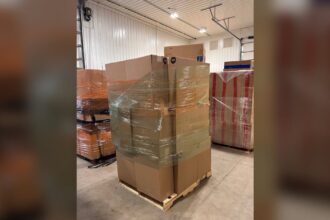The number of Canadians falling ill from salmonella-contaminated salami has surged to 72 confirmed cases, federal health authorities announced Thursday, marking a significant escalation in what has become the country’s most serious foodborne illness outbreak this year.
Public Health Agency of Canada officials report the outbreak has now spread across five provinces, with Ontario bearing the brunt of infections at 41 cases. Quebec follows with 25 reported illnesses, while British Columbia, Alberta, and Manitoba have each documented a smaller number of cases. Twelve patients have required hospitalization—a concerning indicator of the outbreak’s severity.
“We’re seeing an unusually high hospitalization rate with this particular strain,” said Dr. Theresa Tam, Canada’s Chief Public Health Officer. “This suggests the bacterial contamination is either particularly widespread in the affected products or this strain is especially virulent.”
Health officials have linked the outbreak to dry cured salamis produced by Venetian Meat & Salami Co. Ltd., a family-owned operation based in Toronto that distributes products nationwide. The company has issued a voluntary recall for multiple salami products manufactured between September 2023 and March 2024, including their popular Cacciatore, Calabrese Hot, and Sopressata varieties.
“Laboratory analysis has confirmed a genetic match between the bacterial samples taken from patients and those found in tested salami products,” explained Dr. Howard Njoo, Deputy Chief Public Health Officer. “This provides conclusive evidence of the contamination source.”
Food safety experts at the Canadian Food Inspection Agency are conducting trace-back investigations to determine how the contamination occurred. Initial findings suggest potential breakdowns in processing protocols at critical control points where bacteria should have been eliminated.
“Salmonella doesn’t typically survive the curing process if proper acidification and salt concentration are maintained,” noted Dr. Sylvain Charlebois, food policy expert at Dalhousie University. “This suggests either a post-processing contamination or a fundamental failure in the production methods.”
The outbreak has prompted renewed scrutiny of food safety regulations governing ready-to-eat meat products. Unlike fresh meats, dry-cured salamis undergo minimal heating during production, relying instead on salt, acidity, and drying to create an environment hostile to bacterial growth.
“The traditional curing process has been proven safe for centuries,” Dr. Lawrence Goodridge, food safety researcher at the University of Guelph, told CO24 News. “But when corners are cut or modern production scales outpace traditional safety protocols, we see these types of outbreaks.”
Health officials advise consumers to check their refrigerators for recalled products and dispose of them immediately. Symptoms of salmonella infection typically appear 6 to 72 hours after consumption and include fever, severe abdominal cramps, diarrhea, nausea, and vomiting. While most healthy adults recover within a week, young children, pregnant women, the elderly, and immunocompromised individuals face greater risks of severe illness.
The Canadian Food Inspection Agency warns the case count may continue to rise as more infections are confirmed through laboratory testing. They’ve also flagged concerns about potential cross-contamination in retail environments where these products were sliced or handled.
As regulators intensify their investigation, the critical question emerges: is Canada’s approach to regulating ready-to-eat meat products sufficiently robust to prevent future outbreaks, or does this incident reveal fundamental gaps in our food safety system that require immediate attention?


















